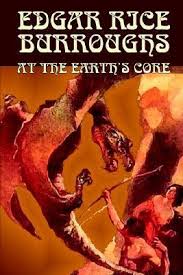Chapter III — At the earths core
byChapter III begins with the narrator being dragged through a shadowy, tangled forest by a creature he cannot fully see or understand. The air is heavy, the silence often broken by strange animal cries, creating an atmosphere of unease. Eventually, the dense foliage opens up to reveal a village unlike anything imaginable—a series of huts woven into the canopy, suspended high above the forest floor. Rope bridges connect each dwelling, and curious creatures with semi-human features swing from branch to branch, observing the newcomer. He is hoisted into one of the huts, poked and examined, but not harmed. Their gestures seem motivated more by fascination than aggression. These beings resemble apes but have organized communities, domesticated animals, and a clear social structure, revealing a civilization that blends primitivism with surprising complexity.
Inside one of the larger huts, the narrator unexpectedly finds Perry, his scholarly companion, seated and visibly relieved. The reunion lightens the mood, providing a moment of levity amid their grim surroundings. Perry excitedly shares his theory that they’ve reached the inside of the Earth, based on geological features, the abundance of prehistoric life, and the omnipresent sun hanging in the sky. Unlike the surface world, this place knows no day or night—the light remains constant, erasing all sense of time. This perpetual noonday creates an unsettling rhythm, one where sleep and hunger become the only guides. Their captors, now more familiar than threatening, feed them basic food and observe them with increasing curiosity. Perry notes that their captors’ language is a blend of sound and gesture, hinting at complex communication.
After several days, the captives are marched out of the treetop village and herded across an expansive plain. The vegetation shifts, the trees thinning into rocky outcrops and sun-baked earth. The journey leads them to a canyon, where the geography grows more ominous with jagged cliffs and tight passages. Their new destination appears more like a prison than a village. Other human prisoners come into view, chained in groups, their faces worn but dignified. Unlike the ape-like creatures, these prisoners exhibit human emotion—resignation, fear, and occasional defiance. This visual cue stirs the narrator’s empathy and a stronger sense of resolve. Despite their own captivity, seeing others in chains hardens their determination to escape.
As the group is marched deeper into what resembles a natural amphitheater, the narrator begins to suspect a brutal purpose behind the relocation. The structure of the valley—its wide floor, tiered sides, and central pit—resembles ancient arenas used for combat or spectacle. Perry, ever the analyst, speculates that the captives may be used for entertainment or ritual sacrifice. While speculation mounts, the physical toll of their journey grows. The oppressive heat and lack of shade weigh heavily, and the monotony of motion without sleep or time erodes morale. The narrator’s internal monologue becomes more reflective, questioning the very essence of existence in a place where time stands still. His sense of isolation is broken only by the shared misery of those around him.
Even in captivity, moments of beauty emerge. Strange flying reptiles cast long shadows against the horizon, and the stones of the valley glow under the ever-bright sky. Despite the danger, wonder still thrives. This balance between awe and terror adds depth to their journey. It’s not just an escape story—it’s a confrontation with the unknown, both within themselves and in the world around them. The protagonist realizes that adaptation is as critical as survival. Every observation, every small detail, could become a tool for freedom. Perry’s theories, once dismissed as fantasy, begin to gain weight. Perhaps this place isn’t just beneath the surface—it’s an entire ecosystem, waiting to be understood or perhaps feared.
By the chapter’s end, the grim future they face becomes more certain. Whatever purpose this natural arena serves, it is unlikely to end well for the captives. Yet, even as that reality looms, the narrator clings to hope. The bond between him and Perry, along with their growing understanding of this strange world, fuels a quiet determination. The chapter closes not with resolution but with readiness—an unspoken vow that their story will not end in chains, no matter how deep beneath the Earth they may be.

